Thai basil is a flavorful herb that can be easily grown at home, providing you with an abundant supply of this delicious herb right at your fingertips. Whether you are a seasoned gardener or just starting out, growing your own Thai basil garden is a fun and rewarding way to add a fresh and unique flavor to your cooking.
Thai basil is a variety of basil with a slightly spicier taste and notes of anise or licorice. It is commonly used in various cuisines, including Thai, Vietnamese, and Laotian, to add an aromatic and fresh flavor to dishes.
When growing Thai basil, it is important to provide it with optimal growing conditions to ensure healthy growth and a bountiful harvest. This includes using a fertile and well-draining soil, providing at least six hours of direct sunlight per day, and making sure the soil stays moist but not waterlogged.
Key Takeaways:
- Thai basil is a flavorful herb with notes of anise or licorice.
- Growing your own Thai basil garden is a fun and rewarding way to have fresh herbs on hand.
- Optimal growing conditions for Thai basil include well-draining soil, six hours of direct sunlight, and regular watering.
The Versatile and Aromatic Thai Basil
Thai basil, belonging to the Ocimum basilicum var. thyrsiflora variety, offers a unique and aromatic flavor that enhances many dishes. This herb is widely used in Southeast Asian cuisines, particularly in Thai, Vietnamese, and Indonesian dishes. Its flavor profile includes a spicier taste with notes of anise or licorice, which sets it apart from other basil varieties.
In addition to its culinary uses, Thai basil is also known for its health benefits. It contains compounds such as eugenol, which has anti-inflammatory properties, and rosmarinic acid, which is an antioxidant that can help protect against cellular damage. Thai basil is also a good source of vitamins A and K, as well as potassium and calcium.
Thai basil can be used in a variety of dishes, from stir-fries and soups to curries and salads. Its versatility makes it a staple in many kitchens, and it can be used fresh or dried, depending on the recipe.
Growing Thai basil at home is a great way to ensure a fresh and steady supply. It can be grown from seeds, cuttings, or transplants and requires well-draining, fertile soil and 6-8 hours of direct sunlight daily. It can be grown both indoors and outdoors, and its compact size makes it suitable for herb gardens or containers. Thai basil plants should be watered regularly, but not waterlogged, and fed with a balanced organic fertilizer once a month.
To maximize Thai basil’s flavor, it is important to prune the plant regularly to encourage the growth of side branches and prevent flowering. Flowering can impair the flavor of the leaves, so pruning is necessary to keep the plant productive. Thai basil leaves can be harvested for culinary use once the plant has grown fully, and they can be stored in the refrigerator for up to a week.

Thai basil can be used in a variety of dishes, from stir-fries and soups to curries and salads. Its versatility makes it a staple in many kitchens.
Propagating Thai Basil: Seeds, Cuttings, and Seedlings
Thai basil can be propagated from seeds, cuttings, or seedlings, giving you multiple options to start growing your own garden. Propagating from seeds is relatively easy and can be done indoors or outdoors. When planting Thai basil seeds, make sure to plant them about a quarter of an inch deep and 12 inches apart. The germination rate of Thai basil seeds is relatively low, so it is recommended to plant a few more seeds than needed. Seeds should emerge within 10 days and will first have two cotyledons before growing true leaves.
If you choose to propagate Thai basil from cuttings, take a stem with a few leaves on it, about four inches long, and place it in a glass of water. In a few weeks, healthy roots will develop, and the cutting can be planted in soil. Make sure to change the water regularly to avoid any bacterial growth that could harm the cutting.
Another option is to use seedlings. Make sure to provide well-draining, loamy, and nutrient-rich soil for seedlings. Before planting them outdoors, harden off seedlings for about a week. Dig a hole slightly wider and deeper than the root ball of the seedling, fill the bottom with well-rotted compost, and place the seedling at the same height it was in the container. Fill in around the sides with soil, gently tamp down, and water.
Regardless of which method you choose, it is important to provide optimal growing conditions for Thai basil to thrive. Thai basil requires full sun exposure, at least 6 hours of direct sunlight per day, and well-draining soil with a pH between 6.0 and 7.5. It prefers regular watering, moist but not waterlogged soil. Pinching off the stems to promote branching and removing flower stalks will help maintain a bushy and productive plant.
With these tips on propagating Thai basil, you can easily start your own herb garden and enjoy fresh and flavorful herbs in your dishes.
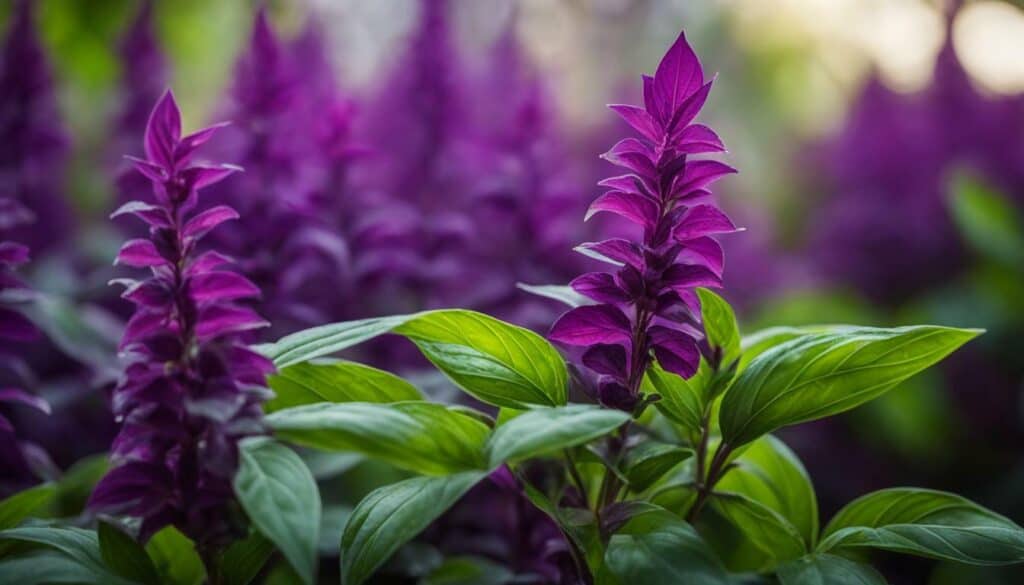
Propagating Thai Basil: A Summary
- Thai basil can be propagated from seeds, cuttings, or seedlings.
- When planting Thai basil seeds, plant them about a quarter of an inch deep and 12 inches apart.
- If propagating from cuttings, place the stem in a glass of water and change the water regularly.
- Provide optimal growing conditions for Thai basil to thrive, including full sun exposure, well-draining soil, and regular watering.
- Pinch off stems and remove flower stalks to promote bushiness and productivity.
Optimal Growing Conditions for Thai Basil
To ensure the successful growth of your Thai basil garden, it’s crucial to provide optimal growing conditions. Thai basil thrives best in well-draining, loamy, and nutrient-rich soil. Before planting, ensure the soil has been mixed with organic matter. Additionally, it requires at least six to eight hours of direct sunlight daily, making it suitable for both indoor and outdoor cultivation.
When propagating Thai basil, it can be grown from seeds, cuttings, or transplants. If planting from seeds, it’s recommended to sow more seeds than needed due to their low germination rate. The seeds should be planted about a quarter of an inch deep and 12 inches apart. When planting from cuttings, select a healthy plant and place it in a cup of water until roots develop.
When planting Thai basil outdoors, it’s important to wait until the last frost has passed and choose a sunny spot with well-draining soil. Regular watering, pruning, and removing flowering stalks are essential for the optimal growth and flavor of Thai basil.
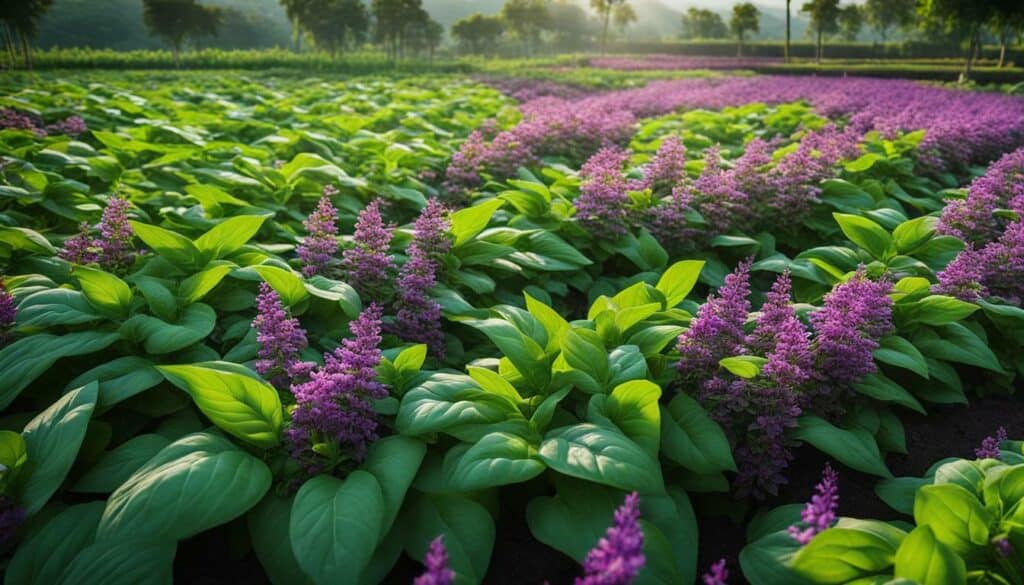
Harvesting the leaves should be done by pinching out stems to promote more side branches and leaves. Thai basil adds a unique flavor to dishes and is a great addition to herb gardens or kitchen gardens.
Pruning and Maintaining Thai Basil Plants
Pruning and maintaining Thai basil plants is essential for their healthy growth and for maximizing their vibrant flavor. As mentioned earlier, pinching out the stems will promote bushiness and more leaves. However, pruning also helps prevent the plant from getting too leggy and producing fewer leaves.
When pruning Thai basil, always use clean and sharp pruning shears or scissors. Trim the stem just above a set of leaves, leaving a small amount of stem intact. This will encourage more growth from the leaf nodes and prevent the plant from becoming too tall.
If your Thai basil plant is producing flower buds, it’s essential to remove them promptly. The flowers will cause the plant to divert its energy away from producing leaves and into seed production. To remove flower buds, clip them off with pruning shears or pinch them off with your fingers.
By properly pruning and maintaining your Thai basil plants, you can ensure that they will continue to produce delicious and aromatic leaves throughout the growing season.
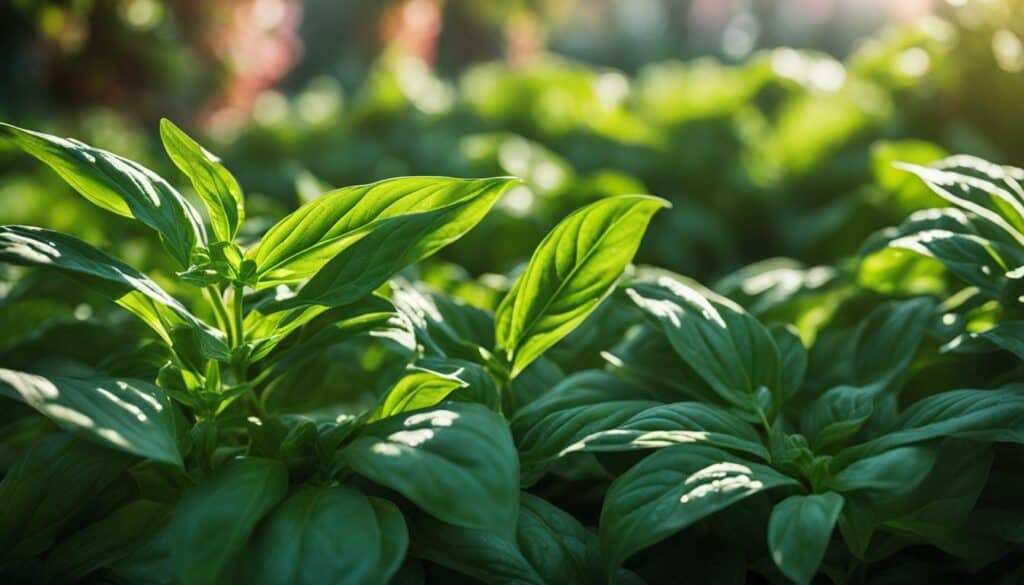
Harvesting Thai Basil Leaves for Culinary Delights
Harvesting Thai basil leaves at the right time is key to enjoy their fragrant aroma and incorporate them into your favorite recipes. The best time to pick the leaves is in the morning when they are at their freshest. Look for leaves that are fully developed and have a bright green color. Avoid leaves that are yellowing or have spots.
When harvesting the leaves, use a pair of sharp scissors or pruning shears to avoid damaging the plant. Cut the stems to the desired length, leaving a few leaves remaining on the plant to encourage new growth. It is recommended to harvest no more than one-third of the plant at a time to allow it to continue growing and producing more leaves.
Thai basil leaves are best used fresh, but can also be stored in the refrigerator for a few days. To store them, wrap the leaves in a damp paper towel and place them in a plastic bag. Alternatively, you can freeze the leaves in a single layer on a tray and then transfer them to a freezer-safe container or bag for later use.
Incorporate Thai basil leaves into your favorite dishes to add a unique flavor and aroma. They pair well with spicy dishes, such as curries and stir-fries, and add a fresh touch to salads and summer rolls.
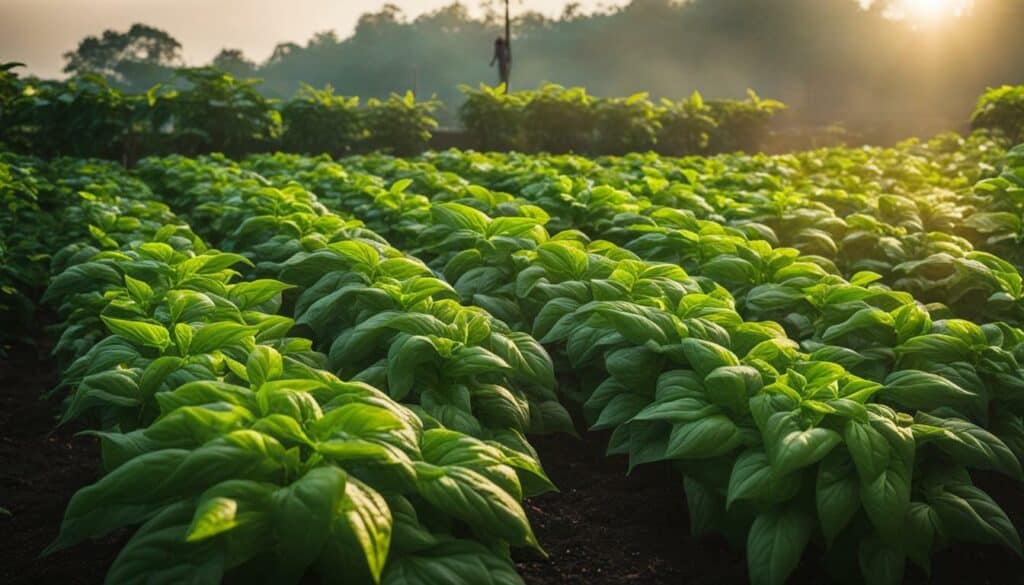
“Thai basil, with its subtle spiciness and notes of anise and clove, is one of the most interesting herbs to cook with.”
If you’re looking for recipe inspiration, try making a classic Thai basil chicken stir-fry or a refreshing Thai basil and watermelon salad. The possibilities are endless when it comes to cooking with this versatile herb.
The Unique Flavor of Thai Basil Shines in These Mouthwatering Recipes
Thai basil adds a distinct licorice-like flavor to dishes that sets it apart from other herb varieties. It’s a popular ingredient in Southeast Asian cuisine and can be used in a variety of dishes, from stir-fries to spring rolls, fried rice, and beyond. Here are some delicious Thai basil recipes to get you started.
Larb Gai
Larb Gai is a flavorful, spicy Thai dish that features ground chicken, fish sauce, lime juice, chilies, and, of course, Thai basil. The combination of flavors creates a complex and satisfying dish that’s perfect for a weeknight dinner.
Thai Basil Fried Rice
This simple but tasty recipe combines cooked rice with stir-fried garlic, onions, chilies, and Thai basil. You can customize it with your protein or veggies of choice. The Thai basil adds a sweet, fragrant twist to this classic dish.
Thai Basil Lemonade
This refreshing drink is perfect for a hot summer day. Fresh lemon juice, Thai basil leaves, sugar, and water combine to create a sweet and tangy drink with a hint of herbal freshness. Add a few slices of lemon or lime for an extra burst of flavor.
Thai Basil Spring Rolls
Spring rolls are a light and tasty appetizer that’s perfect for any occasion. This recipe adds a fragrant and flavorful twist to the traditional dish by adding Thai basil leaves to the filling. Serve it with your favorite dipping sauce for a delicious and satisfying snack.
Pad Kra Pao
Pad kra pao is a classic Thai dish that combines stir-fried meat or tofu with garlic, onions, chilies, and Thai basil. It’s typically served over rice or noodles and can be customized with your choice of protein. The Thai basil leaves add a distinct aroma and taste to the dish.
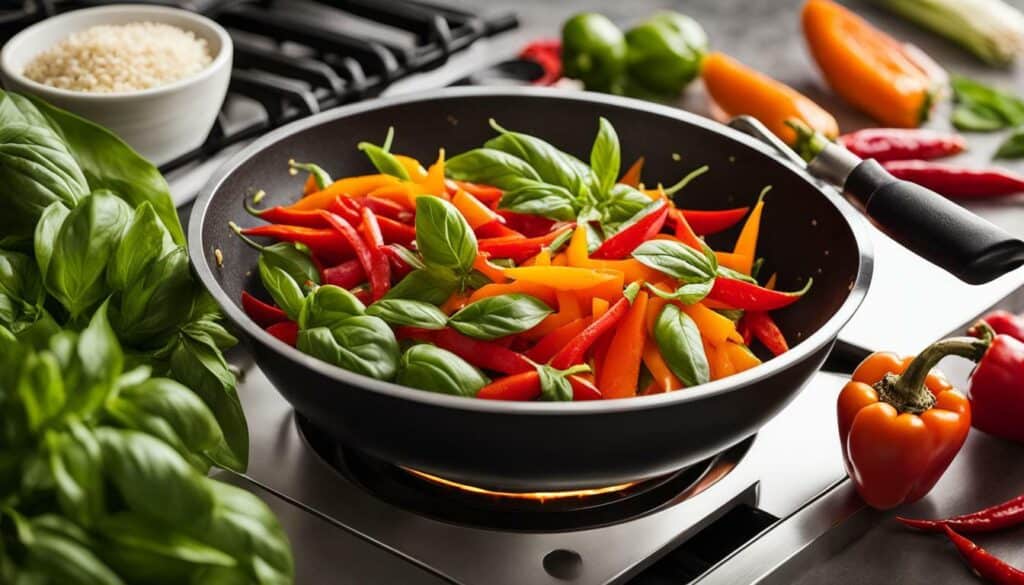
These delicious Thai basil recipes are just the tip of the iceberg. Once you’ve tried them, you can experiment with other dishes that feature this aromatic herb. You can find Thai basil at local Asian grocery stores or grow it in your garden to have a fresh supply on hand.
Thai basil’s unique flavor is perfect for creating mouthwatering dishes that are sure to impress your friends and family. So give these recipes a try and explore the wonderful world of Thai cuisine.
Caring for Thai Basil Indoors
Growing Thai basil indoors is a great option for those without outdoor space, and with the right care, it can flourish beautifully. Thai basil can be grown from seeds, cuttings, or transplants. When growing from seeds, plant them about a quarter of an inch deep and 12 inches apart. The seeds should emerge within 10 days. If growing from cuttings, take a stem with a few leaves and place it in a glass of water until roots form. Then transfer the cutting to a pot with well-draining soil.
Thai basil prefers a warm, sunny location and rich, loamy soil. Water the plant regularly, but be careful not to overwater as it can lead to wilted leaves. Pruning is important to encourage bushier growth and more leaves. Harvest the leaves as needed, making sure to remove any flower stalks as they can affect the flavor of the leaves.
One thing to keep in mind when growing Thai basil indoors is that it may need more light than it would receive naturally, especially in the winter months. Consider using grow lights or placing the plant near a window that receives plenty of sunlight. Also, make sure the temperature is consistent and not too cold, as Thai basil prefers warmer conditions.
By following these tips and giving your Thai basil the proper care, you can enjoy the fresh and flavorful taste of this versatile herb in the comfort of your own home.
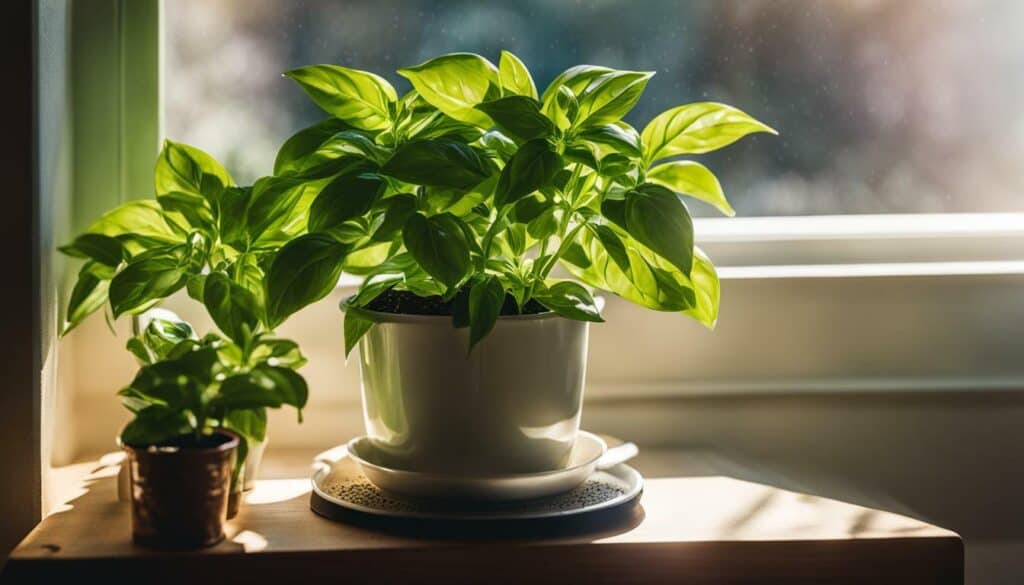
Thai Basil Varieties to Explore
While Thai basil itself offers incredible flavor, there are other varieties you may want to consider growing for an even more diverse herb garden. Here are some Thai basil varieties to explore:
| Variety | Description |
|---|---|
| Siam Queen | This variety is known for its strong licorice flavor and shiny, dark green leaves. |
| Spicy Saber | This variety has a spicy kick and is great for adding heat to dishes. |
| Red Rubin | This variety has deep purple leaves and a slightly milder flavor. |
| Horapha | Also known as holy basil, this variety has a clove-like flavor and is commonly used in Thai cuisine. |
These varieties can be grown in the same manner as Thai basil and can add even more depth and complexity to your herb garden.

Troubleshooting Common Thai Basil Issues
Growing Thai basil may come with its own set of challenges, but with these troubleshooting tips, you’ll be well-prepared to ensure healthy growth.
One common issue when growing Thai basil from seeds is low germination rates. To combat this, it is recommended to sow more seeds than needed to ensure a higher chance of successful germination.
Another important factor to consider is sunlight. Thai basil requires a lot of direct sunlight, at least six hours per day, so it should be placed in a spot that receives ample sunlight. Without enough sunlight, the basil plants may struggle to grow and remain healthy.
Regular watering is crucial to the health of Thai basil plants, but it’s important not to over-water them. Water the plants when the top inch of soil feels dry to the touch, but make sure the soil is not waterlogged as this can lead to root rot.
Pruning is also important to promote bushier growth and increase leaf production. Pinch out the stems regularly to encourage new growth and keep the plant from becoming too leggy.
Lastly, remove any flowering stems as they can impair the flavor of the leaves. By addressing these common issues, Thai basil can thrive and provide a constant supply of aromatic leaves for culinary use.

Remember to keep an eye on your Thai basil plants and make adjustments as needed to ensure they remain healthy and flavorful.
Conclusion
Growing your own Thai basil garden brings the flavors of Thailand right to your doorstep, offering a delightful culinary experience. This flavorful and aromatic herb can be propagated from seeds, cuttings, or transplants. To ensure optimal growth, Thai basil prefers fertile and well-draining soil, and it thrives in sunny locations with at least 6-8 hours of direct sunlight per day. Regular watering is important, keeping the soil moist but not waterlogged.
To promote a bushier plant with more leaves, proper pruning and pinching of the stems is necessary. When it comes to harvesting, it is best to remove the flowering stems to maintain the best flavor of the leaves. Thai basil is a versatile herb that adds a unique twist to various cuisines, making it a worthwhile addition to any herb garden.
Final Thoughts
Overall, growing a Thai basil garden at home is a rewarding experience that can benefit both your taste buds and your health. With a little care and attention, you can enjoy the fresh and flavorful taste of Thai basil in your dishes throughout the year. Why not give it a try and start your herb journey today?
FAQ
Q: How can I propagate Thai basil?
A: Thai basil can be propagated from seeds, cuttings, or seedlings.
Q: What type of soil does Thai basil require?
A: Thai basil requires well-draining, loamy, and rich soil.
Q: How much sunlight does Thai basil need?
A: Thai basil needs at least six hours of direct sunlight per day.
Q: How often should I water Thai basil?
A: Thai basil should be regularly watered to keep the soil moist but not waterlogged.
Q: How can I maintain the shape and enhance the flavor of Thai basil plants?
A: You can maintain the shape and enhance the flavor of Thai basil plants by pinching out the stems and removing flowering stalks.
Q: How do I harvest Thai basil leaves?
A: Thai basil leaves can be harvested by picking them from the plant.
Q: What can Thai basil leaves be used for?
A: Thai basil leaves can be used in various cuisines to add flavor and aroma to dishes.
Q: Can Thai basil be grown indoors?
A: Yes, Thai basil can be grown indoors with the right lighting, temperature, and watering conditions.
Q: Are there different varieties of Thai basil?
A: Yes, there are different varieties of Thai basil that you can explore for added diversity in your garden.
Q: What are some common issues when growing Thai basil?
A: Some common issues when growing Thai basil include pests, diseases, and nutrient deficiencies.
What Are the Best Ways to Store Thai Basil from My Home Garden to Maintain Freshness?
To maintain the freshness of Thai basil from your home garden, follow these storing basil tips for freshness. Firstly, trim the stems and remove any damaged leaves. Next, place the basil in a glass of water and cover it loosely with a plastic bag. Store it at room temperature away from direct sunlight. For long-term storage, freezing the leaves in ice cube trays or blending them with oil and freezing in small containers can be effective.
Source Links
- https://spicerally.com/thai-basil-growing-guide/
- https://gardenerspath.com/plants/herbs/grow-thai-basil/
- https://www.homesandgardens.com/gardens/how-to-grow-thai-basil
- https://thursd.com/articles/thai-basil
- https://cloversgarden.com/products/sweet-thai-basil-plants
- https://www.geturbanleaf.com/blogs/herbs/the-benefits-of-thai-basil-and-why-you-should-be-growing-thai-basil-indoors
- https://www.almostoffgrid.com/blogs/almost-off-grid/growing-thai-basil-from-supermarket-cuttings
- https://www.thespruce.com/thai-basil-7375163
- https://www.gardeners.com/how-to/thai-basil/8673.html
- https://plantophiles.com/plant-care/how-to-prune-thai-basil/
- https://savvygardening.com/how-to-trim-basil/
- https://www.thespruce.com/how-to-harvest-basil-7629152
- https://savvygardening.com/harvesting_basil/
- https://hot-thai-kitchen.com/thai-basil-sauce/
- https://kitchenherbography.com/thai-basil-recipes/
- https://www.eatingthaifood.com/thai-basil-chicken-recipe-pad-kra-pao-gai/
- https://herbswithin.com/growing-thai-basil-indoors/
- https://sproutedgarden.com/basil-varieties/
- https://www.messyvegancook.com/thai-herbs-lemon-basil-holy-basil-thai-basil/
- https://www.amazingherbgarden.com/problems-growing-basil-troubleshooting-guide/
- https://www.ruralsprout.com/basil-problems/
- https://rennieorchards.com/common-problems-with-growing-basil/
- https://thegardenmagazine.com/thai-basil-growing-care-guide/
- https://www.evergreenseeds.com/thai-basil/





Leave a Reply